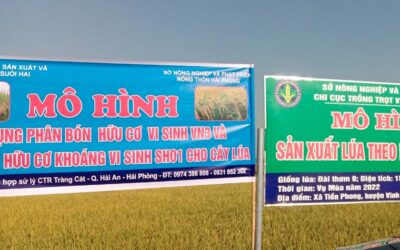The models previously experimented with
Microbial products are primarily used for fertilizer production at the company and in experimental activities. The fertilizers have been supplied to several units for testing on various crops such as rice, vegetables, corn, oranges, tea, etc.
2020:
Collaborated with the Thuy Huong Agricultural Service Production Cooperative in Kien Thuy, Hai Phong to build two experimental models to evaluate the effectiveness of VN3 organic fertilizer. The trials were conducted on cauliflower in Kien Thuy (5 ha) and potatoes in Vinh Bao (10 ha) during the winter crop season. The results showed that using VN3 fertilizer reduced the need for mineral fertilizers, increased yields by over 15%, reduced pest and disease incidence, and decreased the use of pesticides, thereby enhancing farmers’ incomes, producing safe and clean products, and reducing environmental pollution.
2021:
*Spring crop: Collaborated with the Crop Production and Plant Protection Sub-Department of Hai Phong (Hai Phong Department of Agriculture and Rural Development) to build two organic rice cultivation models in the spring season. The VN3 organic fertilizer, SH01 organic mineral fertilizer for first and second applications (without using conventional mineral fertilizers), was used on Hana 167 rice variety in Vinh Bao (5 ha) and BC15 variety in Ngu Phuc (5 ha).
The BC15 rice variety planted in the spring season of 2021 in Ngu Phuc commune, Kien Thuy district, exhibited good growth and development, strong tillering, concentrated and rapid heading, good resistance to pests and diseases, and an estimated yield of 70-75 quintals/ha.
The Hana 167 rice variety planted in the spring of 2021 in Tran Duong commune, Vinh Bao district, showed good growth and development, strong tillering ability, sturdy plants, relatively long panicles, bright grains, high number of effective tillers, and a high percentage of filled grains. The yield reached 6.69 tons/ha, higher than the control field (6.25 tons/ha).
*Summer-autumn crop: Continued testing the organic rice cultivation model in Vinh Bao (5 ha). Initial results showed that the rice plants grew well, were sturdy, had fewer pests and diseases, relatively long panicles, bright grains, and a high percentage of filled grains. The yield reached 7.2 tons/ha.
Collaborated with the Hai Phong Agricultural Extension Center to build an RVT shrimp-rice cultivation model using VN3 microbial organic fertilizer (15 ha) in Ngu Phuc commune, Kien Thuy district. The rice plants grew well, were sturdy, and did not affect the growth and development of shrimp. The yield reached 3.5 tons/ha, 15% higher than usual, with very firm and uniform grains, reducing the loss rate during milling.
2022:
Our company, in collaboration with the Hai Phong Crop Production and Plant Protection Sub-Department, implemented 14 organic rice cultivation models in Vinh Bao district, covering a total area of 244 ha (tested on 4 rice varieties: Nep A sao 47 ha; JO2 50 ha; TBR225 10 ha; Dai Thom 45 ha; BC15 47 ha; QR15 40 ha). Under this model, farmers received 50% support for the company’s organic fertilizer. Despite many challenges such as labor shortages, limited investment, and erratic weather, the models achieved the highest yields and quality rice in Vinh Bao district, second only to Thai Binh province (bright and beautiful rice, few pests, average yield 5.5-6 tons/ha).
Our company also implemented a model using Suoi Hai microbial organic fertilizer in Quang Yen town, Quang Ninh province, covering an area of 2 hectares with the TBR 39 rice variety. The model was divided into 2 plots: one plot fertilized with VN3 microbial organic fertilizer and Suoi Hai organic mineral fertilizer (3 tons/ha) and a control plot using NPK fertilizer according to the standard recommended procedure.
The results showed that the rice plants fertilized with Suoi Hai microbial organic and organic mineral fertilizers developed uniformly, were healthier, and had fewer pests and diseases compared to the locally cultivated fields. Specifically, the field fertilized with Suoi Hai products did not suffer from root suffocation, leaf roller, stem borer, or bacterial stripe diseases; it only experienced mild sheath blight. The yield in the plot fertilized with Suoi Hai products was higher, reaching 5.9-6.0 tons/ha, compared to the control plot, which only reached 5.4-5.5 tons/ha.


